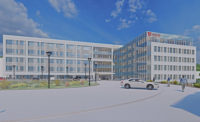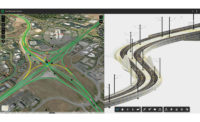In early 2012, Metropolitan State University of Denver approached the CTL|Thompson team for assessments on a brownfield site that the institution hoped to transform into a $25-million athletic facility. The facility would house tennis courts, running paths and athletic fields for Metro State’s baseball, softball and soccer teams.
This would not be the first brownfield site CTL had worked on with Metro State. In 2012 CTL completed work on the university’s Center for Student Success and the Hotel and Hospitality Learning Center, which included a three-phase assessment, including research, soil and groundwater testing and fieldwork to ready these sites for building construction.
The site was highly complex. During testing and excavation, crews unearthed tunnels, bottles and cans from an early 20th century brewery, a water pipe from the late 19th century, and an array of waste ranging from 1930s phone books to chemical contaminants from a former rail yard.
Armed with this experience, the CTL team was optimistic about the challenges of transforming a desolate 13-acre former industrial site into a thriving facility for the university’s athletic teams. After initial site studies, however, the team had to temper its optimism. The site’s challenges would require the most innovative and collaborative thinking.
CTL’s geotechnical and environmental studies revealed both surface and groundwater contaminants and unconsolidated fill, issues that typically require excavation of contaminated soils and replacement with suitable import fill materials. In this case, tens of thousands of yards of debris fill made excavation of the entire complex economically unfeasible. The fill was deeper than 15 ft in some areas, and it had to be compacted properly before constructing fields or tennis courts—but how?
The project pulled together a cross-disciplined team, including CTL engineers who have significant experience with road and bridge assessments, and concluded that deep dynamic compaction, a ground-improvement technique that densifies soils and compacts fills in place by using a 100-ft crane with a 30-ton drop weight, was the best approach.
The solution was nearly without precedent. CTL’s team of engineers, some of whom have practiced in Denver since the early 1970s, could recall only one other time that the technique had been used in Denver. This approach also has its share of “cons.” Slamming a 30-ton weight into the ground repeatedly from a height of 100 ft is disruptive, to say the least. It is loud, and there are potential vibrational impacts to nearby buildings and roads. Soil conditions must be optimal. The client would need to consider such an innovative approach carefully.
The team felt strongly, however, that the “pros” far outweighed the “cons.” Deep dynamic compaction allowed the project team to compact potentially hazardous materials in place rather than hauling away thousands of yards of loose fill, ultimately saving the client up to $3 million in disposal costs.
The method also created a top layer of material across the site that is clean, meeting environmental requirements and ensuring safety for the hundreds of thousands of students and community members who would use the completed facility. Moreover, the future of the site would be more secure, since compaction minimizes differential settlement in buildings, tennis courts and athletic fields.
Even with the pros outweighing the cons, this novel, daring approach requires optimal site conditions in order to be successful. As it happened, the Metro State site was what came to be called a “Goldilocks” property. It was just right.
When evaluating possible use of deep dynamic compaction, highly populated sites are out, due to the impact of noise pollution and vibration to residents. In this case, however, the 13-acre site was vacant and isolated, adjacent only to light industrial structures—only some of which were occupied.
The soil conditions must be just right as well. Too much clay, commonly found in soils along the Front Range, can act as a sponge or reflect back the force of the drop weight. Luckily, the soon-to-be ballfield site was a mixture of sand, clay and debris, the right type of soil to compact properly.
Additionally, the site was large enough so that the approach would become economical and sufficient to mobilize and store specialized equipment. The equipment would need to be brought in from elsewhere in the country—in this case, Chicago.
Aggressive Schedule
With these conditions met, the team presented the solution to Metro State. Because of past successes and the client’s willingness to think creatively, the project gained authorization and moved forward with an aggressive construction timetable. The tennis courts on the property needed to be complete and open for use by August 2013—a mere seven months after we began.
A substantial advantage of deep dynamic compaction is that it allowed work to continue through the wet winter and cold temperatures encountered during this phase of the project. The work stayed on schedule, which would not have been the case had a removal and replacement method been chosen for the material on the site.
Soil excavation and replacement was unavoidable in some areas, such as the new segment of Shoshone Street. Efficiently sorting all of the excavated material and monitoring it for contaminants minimized additional delays. The site once held truck fleets, cold-storage facilities, a railyard for coal and, on adjacent land, a chemical storage company, so the waste material was potentially hazardous, containing buried asbestos, a tank, drains, balls of tar from historical rail maintenance and soil containing lead. Larger items were removed, and soil was sorted into reusable and waste piles. For the majority of the site, however, compaction followed by a clean soil cap mitigated any environmental concerns.
During the weeks when the deep dynamic compaction took place, the team took measures to monitor air quality and vibration from the impact. A daily visual survey of impact craters helped determine when localized remediation or additional engineering controls were needed. Because of the size and scale of the crane and weight, vibrations were monitored around the site perimeter to determine if the drop concussions were affecting nearby structures. There was no significant measurable impact.
The result turned out better than could have been imagined. The compacted material created a smooth, solid surface, well-suited for the university’s tennis courts and sporting fields. The client was glad that this approach promoted public safety and environmental stewardship, and Metro State’s commitment and creativity ultimately revitalized the property and allowed CTL to help transform the university’s vision for this urban campus into a reality. The site also received a No Further Action letter from the Colorado Dept. of Public Health & Environment Voluntary Cleanup and Redevelopment Program, putting an official stamp on this transformative site cleanup and revitalization.
In November, this solution was recognized as the overall best engineering project by the American Council of Engineering Cos. (ACEC) of Colorado. It earned the 2016 Grand Conceptor Award, given by a judging panel only when a project merits this prestigious honor. For this project, the firm next advances to the national ACEC competition, to be held in April in Washington, D.C.
The team’s goal, of course, was to exceed the client’s expectations. Yet the work also set a precedent that may help clients in the future and, ultimately, open opportunities to mitigate brownfield sites across Denver, which is rapidly running out of vacant land. Surely, the properties that can meet the “Goldilocks” criteria are limited, but the successful use of this technique has alerted peers in the industry that the solution is feasible. This project may stimulate new options that are good for both the environment and the economy.
Matthew Wardlow is environmental division manager at CTL|Thompson, a full-service geotechnical, structural, environmental and materials engineering firm. CTL|Thompson is headquartered in Denver and has offices in Fort Collins, Pueblo, Colorado Springs, Glenwood Springs and Summit County and Cheyenne, Wyo.




Post a comment to this article
Report Abusive Comment